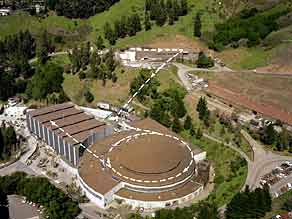|
In 1984, a collaboration of researchers with Berkeley Lab and from GSI
in Germany, working at the Bevalac -- the accelerator configuration when
the Bevatron was coupled to the SuperHILAC -- found the first direct
evidence that nuclear matter can be compressed to high temperature and
density in an accelerator. This marked the first major milestone in the
search for a quark-gluon plasma or QGP.
 |

THE BEVALAC IN WHICH IONS OF HEAVY ELEMENTS, CREATED IN THE
SUPERHILAC (TOP), WERE SENT DOWN A BEAM PIPE FOR FURTHER
ACCELERATION AND EXPERIMENTAL WORK IN THE BEVATRON
|
The evidence discovered was a phenomenon called "collective
flow." In the immediate aftermath of collisions between a beam of
niobium and a niobium target, it was observed that the protons, neutrons
and other subatomic particles released in these collisions hung together
for a fraction of a second before flying apart.
"This was our initial look at how dense nuclear matter
behaves," says Art Poskanzer, a physicist with Berkeley Lab's Nuclear
Science Division (NSD) and one of the leaders of that collective flow
experiment.
Another participant in that collective flow experiment was physicist
Hans Georg Ritter who at the time was with GSI and now heads NSD's
Relativistic Nuclear Collisions program. Says Ritter, "Much of the
basic theoretical and experimental framework for our understanding of
collisions between heavy nuclei was developed at the Bevalac."
Within a few years, the Berkeley Lab researchers had shifted their
focus to the Super Proton Synchrotron (SPS) at CERN where collision
energies were 100 times higher than could be reached at the Bevalac. In
collaboration with scientists from GSI and CERN, they initiated a
relativistic heavy ion program. Lab researchers helped construct an
injector that initially enabled the SPS to accelerate oxygen and sulfur to
relativistic energies, and eventually to produce the lead-lead collisions
whose results are now being reported.
In a head-on collision between two beams of lead nuclei in the SPS,
about 2,500 particles are created, virtually all of them hadrons. Since a
change-of-state from ordinary matter to a QGP is almost immediately
followed by a change back to ordinary matter, the plasma's existence must
be inferred by studying its final products. This requires an elaborate
system of detectors.
Berkeley Lab researchers played a major part in the construction of
several critical detector systems for the SPS heavy ion program. They also
played a major part in the science done on those detectors.
The tradition of Berkeley Lab contributions to detectors aimed at
capturing the elusive QGP has continued with the new facility at
Brookhaven called the Relativistic Heavy Ion Collider or RHIC. Berkeley
Lab scientists and engineers led the collaboration that designed and
constructed STAR -- the Solenoid Tracker At RHIC -- one of the
accelerator's two giant detector systems. They will be major participants
in the science there as well.
Additional Information:
|


